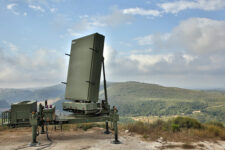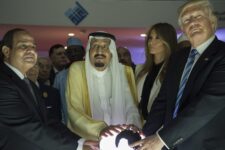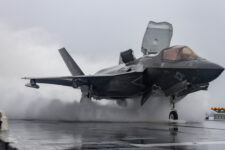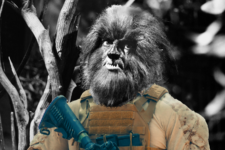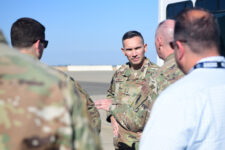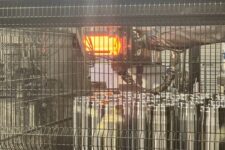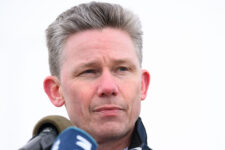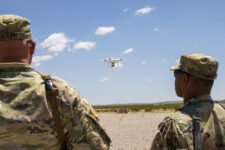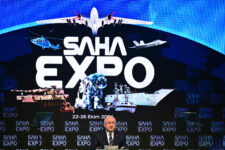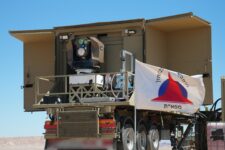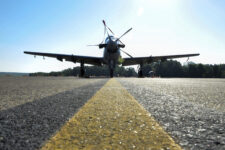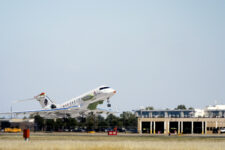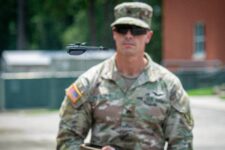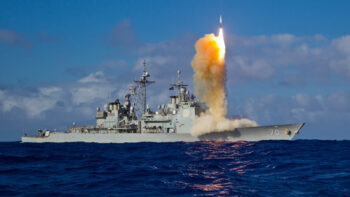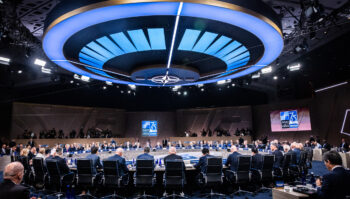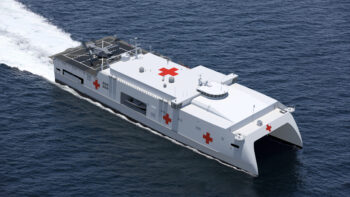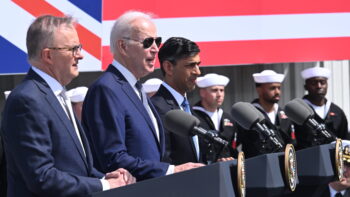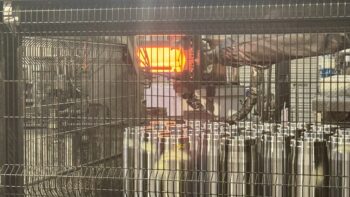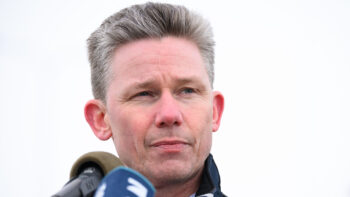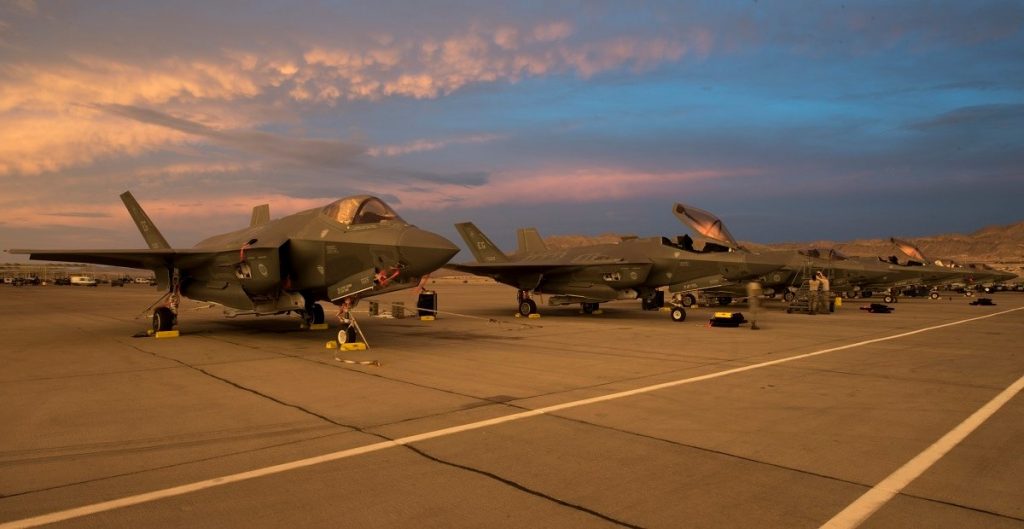
F-35A Joint Strike Fighters on the flight line at Nellis Air Force Base.
UPDATED with Navy, Air Force comment WASHINGTON: The Air Force’s annual classified conference on command & control will host an unprecedented Army delegation next week as the two services wrestle with how to coordinate better in a future war. In fact, senior officers from all four services will attend the C2 Summit 2020 – traditionally been an Air Force event – at Nellis Air Force Base.
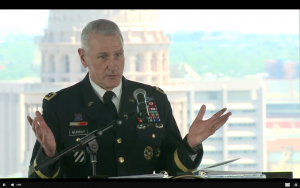
Gen. John Murray, first chief of Army Futures Command, speaks at its formal activation in Austin.
That said, while a draft guest list obtained by Breaking Defense included dozens of Air Force generals and half-a-dozen from the Army, there was just one Marine general and one Navy admiral. UPDATE That’s Rear Adm. Richard Brophy, who as commander of the Naval Aviation Warfighting Development Center (NAWDC) naturally works more closely with the Air Force than, say, submariner or surface ship captain. UPDATE ENDS
That’s just the latest sign that the sea services remain ambivalent about subordinating themselves to what’s now being called Joint All Domain Command & Control.
UPDATE “We’re all in” on JADC2, a Navy spokesperson told me this weekend. But many Navy leaders had longstanding commitments this coming week at the annual Surface Navy Association conference in Washington, DC, preventing them from going to Nellis in Nevada. UPDATE ENDS
While Navy brass have recently pledged to join the JADC2 effort, they also have a tradition of independence that dates back to when the Navy Department – which includes the Marines – and the War Department – which ran both the Army and what became the Air Force – were separate cabinet agencies.
“Representatives will be present from US Air Force, US Army, US Navy and US Marine Corps,” confirmed Leah Garton, a spokesperson for Air Combat Command, which organizes the annual event.
While there have been some non-Air Force attendees in the past, the spokesperson continued, “there’s certainly an increased emphasis this year in working together with our joint service partners as this year’s C2 Summit theme is Joint All-Domain Command and Control.”
ACC wouldn’t release a list of participants for security reasons, but Breaking Defense was able to confirm four high-ranking Army attendees:
Gen. John “Mike” Murray is the founding chief of Army Futures Command, created in 2018 to overhaul the Army’s ailing modernization efforts by bringing together experts and officials previously scattered in separate and often rivalrous bureaucracies. Two of his direct subordinates will attend as well:
- Lt. Gen. Eric Wesley leads one of Future Command’s three main branches, the Futures & Concepts Center (formerly ARCIC) at Fort Eustis, Va. That’s the internal Army think-tank that, under the leadership of Lt. Gen. H.R. McMaster, came up with the concept they initially called Multi-Domain Battle.
- Maj. Gen. Peter Gallagher is director of the Network Cross Functional Team, one of eight hand-picked CFTs that work on the Army’s top modernization priorities. Gallagher’s team is overseeing a top-to-bottom overhaul of the Army’s command, control, and communications networks – a new system that must be compatible with the other services’.
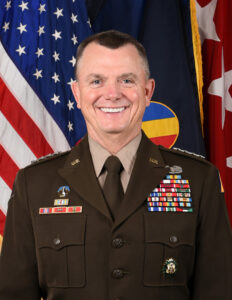
Gen. Paul Funk
Gen. Paul Funk leads TRADOC, the Army’s Training & Doctrine Command, headquartered at Fort Eustis, which oversees everything from recruiting to basic training to graduate-level courses for senior NCOs and future generals. TRADOC is reevaluating all training, education, and leader development programs to better prepare young Army officers to work more closely with the other services in future multi-domain operations. What became Futures & Concepts Center was originally part of TRADOC as well, but was moved to Army Futures Command in 2018.
It’s clear that the Air Force and Army are making a major push for a new kind of joint command system to wage a new kind of war – from long-range exchanges of precision-guided missiles to “grey zone” conflicts of disinformation and proxy forces.
Air Combat Command, which hosts the C2 Summit, has been the Army’s closest partner on all things multi-domain. Its chief, Gen. Mike Holmes, has been a leading advocate for new kinds of command, control, and collaboration. And ACC’s base at Nellis not only houses the Air Force Weapons School, the service’s training center for advanced tactics, but its two-year-old Shadow Operations Center, formed specifically to experiment with Multi-Domain Operations.

Air Force Chief Architect Preston Dunlap (left) and Brig. Gen. David Kumashiro (right) at the Defense One Outlook 2020 conference.
UPDATE Briefing the conference on both the Shadow Ops Center and recent joint experiments with the Air Force’s Advanced Battle Management System (ABMS) will be Brig. Gen. David Kumashiro, who runs joint integration initiatives for the Air Force Chief of Staff, Gen. David Goldfein, himself an enthusiastic supporter of all-domain C2. Also attending is the Air Force’s recently hired Chief Architect, Preston Dunlap, who’s masterminding many of the JADC2 experiments.
“The significance of this conference is that we are able to highlight the imperative of JADC2 and the ABMS Family of Systems,” Brig. Gen. Kumashiro told Breaking Defense in an email Saturday. “This senior leader summit emphasizes and underscores the inherent jointness of our operating concept, as well our continuing efforts to strengthen our alignment and synchronization with the other Services (special shout out to the Space Force). This open and transparent warfighter-led dialog will be the most compelling aspect of the Summit.” UPDATE ENDS
For all the emphasis on jointness, though, the C2 Summit remains an Air Force event, and the number of Air Force generals attending is a little dizzying. We’ve not confirmed all these names as yet, but let’s give you a selection of just some of the Air Force four-stars alone:
- Gen. Charles Q. Brown, commander, Pacific Air Forces
- Gen. Arnold Bunch, commander, Air Force Materiel Command
- Gen. Jeffrey Harrigian, commander, US Air Forces Europe
- Gen. James M. “Mike” Holmes, commander, Air Combat Command
- Gen. Maryanne Miller, commander, Air Mobility Command
- Gen. Timothy Ray, commander, Air Force Global Strike Command
- Gen. John Raymond, commander, Air Force Space Command.
We’ll update this story as we confirm more high-level participants and follow up with what we learn about the conference itself — without leaking any classified information.
